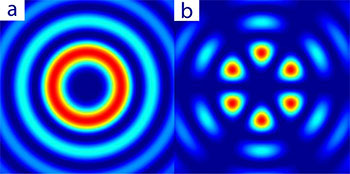
Combining two structured light fields (left) with opposite helicities, the research team created a rotating light field whose intensity petals speed up as they spin (right). [Image: Andrew Forbes/Wits University]
A team of scientists from Germany, Kenya, and South Africa, led by OSA Senior Member Andrew Forbes of the University of the Witwatersrand, have provided the first demonstration of angular acceleration of a structured light field (Phys. Rev. A, doi: 10.1103/PhysRevA.91.043821). The team envisions potential uses for this new class of light field both in studies of fundamental physical processes and in applications for optically driven microfluidic flow.
While it’s well known that light travels at a constant forward speed in a given medium, studies with Airy beams, Bessel beams and some other structured light fields have found that certain features of the field show apparent transverse acceleration (i.e., acceleration perpendicular to the propagation direction). The potential usefulness of those accelerations, however, is limited because, by definition, they rapidly spread out the light’s propagation angles and the lateral extent of the light field becomes, in principle, unbounded.
To overcome those limitations, Forbes and colleagues looked at options for initiating and controlling angular acceleration in rotating light fields. These “twisted” light fields—structured light fields that have been given orbital angular momentum, and for which the intensity maxima gyrate around the optical axis—have previously been experimentally demonstrated and even used to move tiny trapped particles. But thus far, researchers had only created twisted fields with a constant angular velocity.
Examining the mathematics of twisted light, the team found that by engineering the structured light field to include a nonlinear phase variation as a function of the rotational angle, they should be able to create an angular acceleration of the beam profile. They created such a field out of a superposition of two twisting beams with opposite helicities, by passing a plane wave through digital holograms of two different ring-slit apertures, each encoded with a different azimuthal phase variation. They captured the results as rotating intensity “petal” structures using a CCD camera.
The experiments demonstrated the angular acceleration in the petal structure that had been predicted in the mathematics, as shown in the video below:
The team also found that, as expected, they could vary the acceleration when a single morphology parameter in the digital holograms was tweaked.
Forbes and colleagues also stress that, notwithstanding the acceleration, angular momentum is conserved in the system. That’s because the total optical field actually consists of two coupled structures: the dominant, accelerating central structure depicted above, and a correspondingly decelerating lower-intensity structure dispersed over a broader area. The offsetting combination of the two structures allows the angular momentum of the entire field to stay constant.
